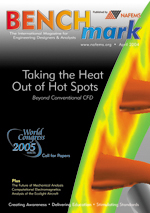BENCHmark April 2004
Taking the Heat out of Hot Spots - Beyond conventional CFD
 In this Issue:
In this Issue:
The title of one of the feature articles in this issue of BENCHmark “The Future of Mechanical Analysis” prompted me to consider what the future holds for the engineering simulation community.
In general, economic results and the prediction of future trends are mixed. However, there appears to be a growing number of optimists who are starting to see the first shoots of economic recovery in the engineering sectors of Europe and North America.
Fortunately, the CAE industry as a whole appears to be in reasonably good health. Reviewing the financial results for last year which have recently been published from some of the major software vendors, the overall trend is a substantial improvement over the previous year. We can confidently expect this to lead to further investments by software developers in new technologies, which will ultimately be of clear benefit to all users.
As we can see from the variety of applications covered by the articles in this issue of BENCHmark, engineering simulation plays a part in a truly vast range of technologies. This range will only continue to grow. Take just one measure of this: the length scale.
At one end of the scale - the exploration of space - the close liaison which exists between both NASA and ESA with NAFEMS is evidence of the tremendously important role that simulation plays in the space industry. The ambitious hopes for future missions that have recently been announced by President Bush will undoubtedly stimulate vibrant growth in the use of technology within this sector.
At the other end of the length scale, the interest in the potential uses of nanotechnology continues unabated. Within Europe, this is underlined by the emphasis placed on nanotechnology in the funding available for research. Many researchers are looking towards simulation technologies to assist them in this field. It would appear that the future is bright for engineering analysis.
Tim Morris Chief Operating Officer
April 2004

 In this Issue:
In this Issue:
